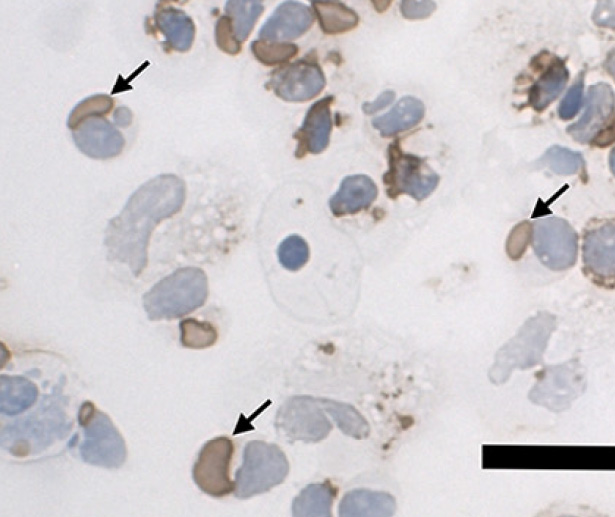Abstract
Inclusion body disease (IBD) of boas and pythons is characterized by the intracytoplasmic accumulation of an antigenic 68 kDa viral protein IBDP, more recently known as the nucleoprotein (NP) of the reptarenaviruses. Blood samples of 131 captive boas and pythons (53 boa constrictors, Boa constrictor; 35 rainbow boas, Epicrates cenchria; 22 ball pythons, Python regius; 5 carpet pythons, Morelia spilota; 6 Burmese pythons, Python bivittatus; 4 Jamaican boas, Epicrates subflavus; 5 anacondas, Eunectes spp.; and 1 green tree python, Morelia viridis) were obtained from 28 collections in the USA. Diagnosis of IBD was initially made by the identification of eosinophilic intracytoplasmic inclusion bodies in hematoxylin and eosin (HE) stained blood films and isolated peripheral white blood cells (PWBC). The overall prevalence of IBD in study snakes was 25/131 or 19% (95% CI = 12.4%, 25.8%) with boa constrictors being more commonly infected (22/53 or 41.5%; 95% CI = 28.2%, 54.8%) than other species in this study. Of the 22 IBD positive boa constrictors, 87% were clinically healthy, 13% had various signs of chronic illness, and none showed signs of central nervous system disease. Using a validated monoclonal anti-NP antibody, NP was confirmed within the isolated PWBC by immunohistochemical staining and Western blots. The presence of reptarenaviruses within blood samples of 27 boa constrictors and three rainbow boas was also assessed by PCR. Among boa constrictors, very good agreements were shown between the observation of inclusion bodies (by HE stain) and the presence of NP (by immunohistochemistry, kappa = 0.92; and Western blots, kappa = 0.89), or the presence of reptarenaviruses (by PCR; kappa = 0.92).
Comment
This paper was largely the work of Rita Chang and Elliott Jacobson, who literally wrote the textbook on reptile infectious diseases. We contributed by assessing reptarenavirus prevalence using PCR.
